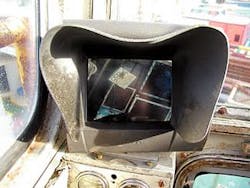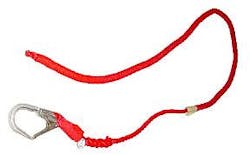In its drilling operations worldwide, Noble Corp. has reduced reportable hand and finger injuries resulting from material-handling incidents among rig employees by two thirds over a three-year period.
Noble managers reported 15 hand injuries resulting from material-handling activities in 2000, 12 in 2001, 9 in 2002, and 2 in the first half of 2003.
Noble attributes the dramatic reduction in injuries to three primary factors:
1. Mandatory use of taglines to guide crane-delivered cargo from shipping vessels to the rig deck.
2. Use of night-vision, closed-circuit television cameras in the boom tips of rig cranes.
3. Implementation of a comprehensive safety policy within the company.
Closed-circuit cameras are focused on the deck to give rig-crane operators an unobstructed view of the target area where the load is to be placed (Fig. 1). With this system, personnel or obstructions within the loading area are easily detected.
null
null
Safety evolution
Most of the Noble injuries associated with material handling occurred while a crane was transferring a load to the deck or to another vessel. When the cargo began to swing in the wrong direction, workers standing nearby would sometimes extend a hand to guide it.
Because the cargo was in motion and the worker responded on impulse rather than carrying out a planned task, his hands and fingers could be caught between the cargo and another object, causing injury. Depending on circumstances, the resulting hand and finger injuries ranged widely in severity. Once Noble determined how the injuries were occurring, it set out to devise an action plan to help prevent them.
During second quarter 2001, Noble assembled a team to discuss ideas for reducing the number of injuries to workers' hands and fingers. Each division within the company was asked to choose two rigs that would participate in a "hands free" pilot program. The theme reinforced the idea that if the worker never touched the cargo directly, his chances of being injured were greatly reduced. The team then collected feedback from eight participating rigs over a 3-month period.
The program proved to be so successful that by August 2001, a formal "hands-free" policy had been developed and approved for implementation fleetwide.
The team's concept for a hands-free work environment was a simple one: "No person working on board a Noble rig will touch a load, sling, or wire line while a load is suspended and there is tension in the rigging. All loads will be controlled through the use of dedicated taglines or by the crane and its operator."
The policy states that all deck-to-deck lifts will be controlled with a minimum of two taglines. All boat-to-deck lifts that do not have a tagline attached (Fig. 2) will be landed on the rig with all personnel well clear. "Well clear" is interpreted as more than 30 ft (9 m) away.
Taglines will then be attached, and the lift will be treated as "deck to deck," with workers handling only the taglines, not touching the cargo itself. The policy also mandates that all taglines meet Noble's quality standards and that any worker using a tagline shall position him or herself at least 10 ft (3 m) from the load.
Fig. 3 illustrates the use of taglines to guide a heavy load to its resting place. Note that the ropes are rigid enough to resist twisting and tangling, conditions that could lead to serious injury.
null
At no time is a crane line to be touched unless the line is fully slack and there is no motion of the crane or load. A line is not considered slack if it is supporting the weight of the fast-line ball or main block.
The crane operator must signal approval before the worker touches the line.
The operator will approve the line being touched only when the crane is secured and the line is fully slack.
Recognizing that there will be instances in which the hands-free policy is not applicable, Noble also drafted a policy for deviation:
- If, for any reason, a load is encountered that requires "hands on" manipulation, approval must be obtained from the offshore installation manager (OIM) or rig manager before the load is moved.
- If the OIM-rig manager approves the lift, a pretask toolbox talk will be held that will include a review of a new or existing job safety analysis.
- The OIM-rig manager will record his approval on a STOP (Safety Training and Observation Program) card as he observes the lift. These observations can be shared with other crews to help prevent future safety incidents.
Noble's message to workers is clear: If an unusual circumstance occurs, the worker must obtain advance permission before taking action. Without permission, the worker should not take the action.
This straightforward approach in analyzing everyday work tasks, coupled with the requirement for the use of "tangle-free" tag lines, has served Noble and its employees well. The program has not only helped to reduce hand and finger-related injuries, but has also increased overall safety awareness, which has helped reduce the total incidence of injuries.
ASP program
The International Association of Drilling Contractors (IADC) administers an Accident Statistics Program (ASP) for its members.1 Member companies voluntarily submit monthly reports of detailed statistics on injury accidents and illnesses within specified levels of severity.
The IADC compiles the data and reports the results back to the drilling company.
Participating companies gain valuable insight into their safety programs by studying the ASP results.
Participants report each work-related, recordable injury or illness, in these categories: fatality, lost-time incident, days away from work case, restricted work case, and medical treatment only. First-aid cases, defined as treatment of minor scratches, cuts, burns, splinters, etc., are not reported.
ASP definitions for injury categories:
Lost-time incident. A work-related incident (injury or illness) in which a physician or licensed health care professional recommends days away from work due to the incident.
- Medical treatment only. Any work-related injury or illness requiring treatment beyond first aid but not resulting in a restricted work case or lost-time incident.
- Recordable incident (injury or illness). An incident in which, regardless of where signs or symptoms surface, a work event or exposure is a discernable cause of injury or illness or a significant aggravation to a preexisting condition.
- Restricted work case. A case in which an employee cannot perform all of the routine job functions but does not miss days at work.
Work related. A case in which an event or exposure in the work environment is the discernable cause or a contributor to an injury or illness or significantly aggravates a preexisting injury or illness.
Reference
1. 2002 ASP Program, Rig Official Rules and Guidelines, International Association of Drilling Contractors, Jan. 1, 2002.
Tagline properties
Taglines (Fig. 2) are hand-made, following these steps:
Attach a stainless steel eyehook to a length of twisted rope.
Dip the rope in a vat of liquid polyurethane until the rope is saturated.
Coat the gripping area with polyester resin.
Wrap the gripping area in tight coils with 5/16-in. nylon rope. When the resin cures, it bonds the wrapping to the rope, providing an all-weather, nonslip surface on the gripping area. Untreated rope is slippery when wet and can deteriorate rapidly when exposed to weather or chafing. If a tagline is made of a limber material, it may contribute to more injuries from tangling and hanging up on obstructions.
The author
Mike Cadigan is health, safety, environment, and quality (HSEQ) manager for Noble Corp in Sugar Land, Tex. He has over 8 years of experience in the oil industry and has held various HSEQ positions in Canada, Europe, and the US. Cadigan holds a bachelor of commerce from Memorial University in St. John's, Newf.




